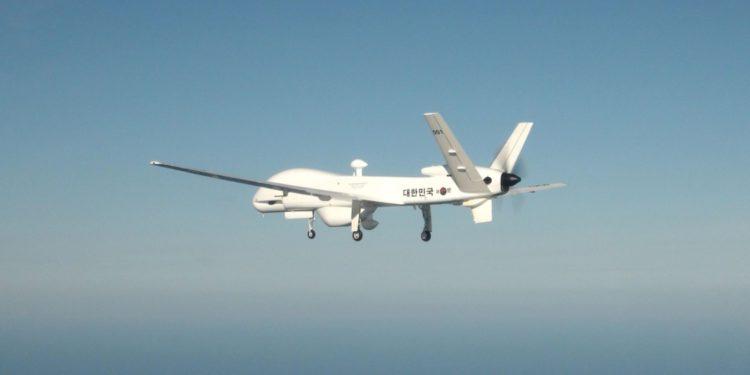South Korea has initiated the mass production of a newly designed multi-purpose medium-altitude unmanned aerial vehicle (UAV) named ‘Korean Reaper,’ aiming to strengthen military surveillance capabilities over North Korea.
The Defense Acquisition Program Administration (DAPA) sealed a 471.7 billion won deal in December with Korean Air, the country’s largest airline, in collaboration with defense firms LIG Nex1 and Hanwha Systems. With the partnership, South Korea will develop advanced spy drones, with the envisioned completion set for 2028.
The Korean Reaper, a medium-altitude unmanned aerial vehicle, is expected to enhance military capabilities and expand the nation’s monitoring reach. The MUAV project, initiated by the state-run Agency for Defense Development in 2008, culminated in 2022.
The result is a highly advanced surveillance aircraft designed to operate at altitudes between 10 to 12 kilometers. These spy drones, measuring 13 meters in length and 3 meters in height, have a wingspan of 25 meters. The drones will be able to capture high-resolution images from distances exceeding 100 kilometers. The impressive dimensions of these drones, coupled with their advanced imaging capabilities, position them as key assets for the South Korean Army.
The Defense Acquisition Program Administration (DAPA) anticipates that introducing the spy drone will augment the surveillance and reconnaissance capabilities of the South Korean military. With the advanced technology, the country aims to ensure heightened security measures in the face of evolving geopolitical challenges.
South Korea embraces artificial intelligence (AI) systems for enhanced surveillance along its northern border. Incorporating AI in surveillance posts will replace outdated systems, providing the military with improved threat detection capabilities.
This modernization effort comes at a crucial time when tensions between North and South Korea are rising. In November last year, North Korea decided to halt the implementation of a 2018 military agreement designed to mitigate friction in the demilitarized zone areas.
The MUAV is set to be equipped with advanced weaponry, including domestically produced anti-tank missiles called Cheongeom. Notably, the MUAV is expected to surpass the capabilities of the American MQ-9 Reaper in certain aspects.
With a 1,200-horsepower turboprop engine, exceeding the Reaper’s 900-horsepower engine, and an extended operational time of 24 hours compared to the Reaper’s 14 hours, the MUAV has the ability to carry heavier armaments and maintain longer air operations.
South Korea’s journey to develop the MUAV faced challenges, starting with initial discussions in 2006 and the initiation of development in 2008. The project encountered delays, including a temporary halt in 2011 when the government opted for the Global Hawk from the United States.
Postponements and technical issues persisted until March 2022, when the MUAV finally met all relevant defense equipment standards. In December of the previous year, the Defense Acquisition Program Administration (DAPA) signed a mass production contract with Korean Air, LIG Nex1, and Hanwha Systems.
DAPA envisions further modifications and development for the MUAVs, anticipating their application in various fields, including coast guard and firefighting activities, with potential contributions to South Korea’s defense exports.
Also Read:
- OpenAI CEO Sam Altman Explores Semiconductor Collaboration with Samsung and SK Hynix in South Korea
- South Korean Government Elevates Support for U-Turn Investments in High-Tech Sectors
- Hyundai Mobis Innovates with Human-Centric Lighting for Future Mobility Environments
- KT Unveils AI Lingo Phone: A Tailored Solution for Small Business Success
- Kakao Unveils Honeybee: A Multimodal Large Language Model Transforming AI Boundaries







